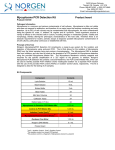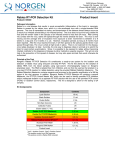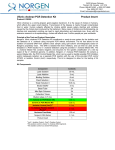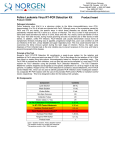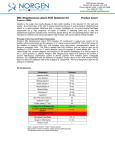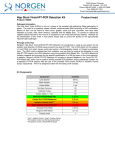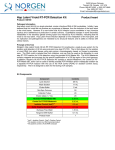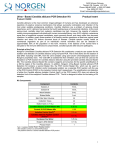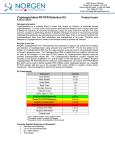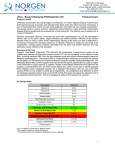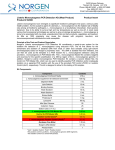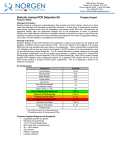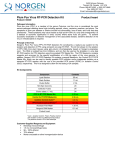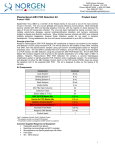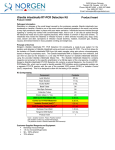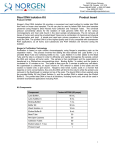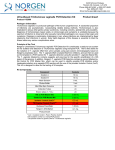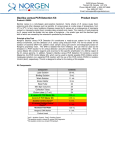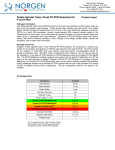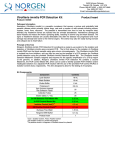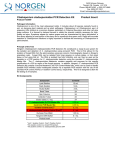Download Saccharomyces cerevisiae PCR Detection Kit
Transcript
3430 Schmon Parkway Thorold, ON, Canada L2V 4Y6 Phone: 866-667-4362 • (905) 227-8848 Fax: (905) 227-1061 Email: [email protected] Saccharomyces cerevisiae PCR Detection Kit Product Insert Product # 33300 Pathogen Information Saccharomyces cerevisiae plays a beneficial role in wine fermentation, in which it is the predominant species. Despite the beneficial role of S. cerevisiae in the food industry for food and beverage production, it is able to cause spoilage in wines. Uncontrolled yeast growth can alter the chemical composition of wine, detracting from its sensory properties of appearance, aroma, and flavour. If these faults are severe, the wine is rejected by consumers. S. cerevisiae contamination is found mainly in sweet wines, where fermentable sugar can support growth, and also in semidry bottled wines. Therefore a rapid and sensitive method to detect S. cerevisiae contamination is required to prevent wine spoilage. Principle of the Test Norgen’s Saccharomyces cerevisiae PCR Detection Kit constituents a ready-to-use system for the isolation and detection of S. cerevisiae using end-point PCR. The kit first allows for the isolation of fungal DNA using spin-column chromatography based on Norgen’s proprietary resin. Fungal DNA can be isolated from cultures, plant samples,or from beverage samples including wine and grape juice using this kit. The DNA is isolated free from inhibitors, and can then be used as the template in a PCR reaction for S. cerevisiae detection using the provided S. cerevisiae Master Mix. The S. cerevisiae Master Mix contains reagents and enzymes for the specific amplification of a 301 bp region of the fungal genome. In addition, Norgen’s S. cerevisiae PCR Detection Kit contains a second heterologous amplification system to identify possible PCR inhibition and/or inadequate isolation. The amplification and detection of either the Isolation Control (IsoC) or the PCR control (PC) does not reduce the detection limit of the analytical S. cerevisiae PCR. This kit is designed to allow for the testing of 24 samples. Kit Components: Component Contents Lysis Solution 15 mL Wash Solution 9 mL Elution Buffer 3 mL Bead Tubes 24 Mini Spin Columns 24 Collection Tubes 24 Elution tubes (1.7 mL) 24 Sacc 2x Detection PCR Master Mix 0.35 mL Control 2x PCR Master Mix 0.35 mL Isolation Control (IsoC) *a Sacc Positive Control (PosC) 0.3 mL *b 1.25 mL Norgen’s DNA Marker 0.1 mL Product Insert 1 * IsoC = Isolation Control ; PosC= Positive Control a b 0.1 mL Nuclease Free-Water The isolation control is a cloned PCR product. The positive control is S. cerevisiae genomic DNA Customer-Supplied Reagents and Equipment • Disposable powder-free gloves • Benchtop microcentrifuge • 1.5 mL microcentrifuge tubes • 65°C water bath or heating block • 96 – 100% ethanol • 70% ethanol • RNase A (optional) • Lyticase (optional) Storage Conditions and Product Stability All buffers should be kept tightly sealed and stored at room temperature (15-25oC). Buffers can be stored for up to 1 year without showing any reduction in performance. The Sacc 2x PCR Master Mix, Control 2x PCR Master Mix, Sacc Positive Control (PosC) and the Isolation Control (IsoC) should be kept tightly sealed and stored at -20oC for up to 1 year without showing any reduction in performance. Repeated thawing and freezing (> 2 x) should be avoided, as this may reduce the sensitivity. If the reagents are to be used only intermittently, they should be frozen in aliquots. General Precautions The user should exercise the following precautions when using the kit: • Use sterile pipette tips with filters. • Store and extract positive material (specimens, controls and amplicons) separately from all other reagents and add it to the reaction mix in a spatially separated facility. • Thaw all components thoroughly at room temperature before starting an assay. • When thawed, mix the components and centrifuge briefly. • Work quickly on ice. Quality Control In accordance with Norgen’s ISO 9001 and ISO 13485-certified Quality Management System, each lot of Norgen’s Sacc 2x PCR Master Mix, Control 2x PCR Master Mix, Sacc Positive Control (PosC) and the Isolation Control (IsoC)are tested against predetermined specifications to ensure consistent product quality. Product Use Limitations Norgen’s S. cerevisiae PCR Detection Kit is designed for research purposes only. It is not intended for human or diagnostic use. Product Warranty and Satisfaction Guarantee NORGEN BIOTEK CORPORATION guarantees the performance of all products in the manner described in our product manual. The customer must determine the suitability of the product for its particular use. Safety Information Ensure that a suitable lab coat, disposable gloves and protective goggles are worn when working with chemicals. For more information, please consult the appropriate Material Safety Data Sheets (MSDSs). These are available as convenient PDF files online at www.norgenbiotek.com. CAUTION: DO NOT add bleach or acidic solutions directly to the sample-preparation waste. Protocol A. Saccharomyces cerevisiae Genomic DNA Isolation Important Notes Prior to Beginning Protocol: • • • • • • • • A variable speed centrifuge should be used for maximum kit performance. If a variable speed centrifuge is not available a fixed speed centrifuge can be used, however reduced yields may be observed. Ensure that all solutions are at room temperature prior to use, and that no precipitates have formed. If necessary, warm the solutions and mix well until the solutions become clear again. Prepare a working concentration of the Wash Solution by adding 21 mL of 96 - 100 % ethanol (provided by the user) to the supplied bottle containing the concentrated Wash Solution. This will give a final volume of 30 mL. The label on the bottle has a box that may be checked to indicate that the ethanol has been added. Lysate can be prepared from either fungi growing on plates, plant tissue or fruit. Please ensure that you follow the proper procedure for lysate preparation in Step 1a. For the isolation of genomic DNA from fungi growing on plates, Collection Solution must be prepared. Collection Solution consists of 0.9% (w/v) NaCl prepared with distilled water. Preheat a water bath or heating block to 65°C. Isolation Control (IsoC) An Isolation Control (IsoC) is supplied. This allows the user to control the DNA isolation procedure. For this assay, add the Isolation Control (IsoC) to the lysate during the isolation procedure The Isolation Control (IsoC) must not be added to the sample material directly. Do not freeze and thaw the Isolation Control (IsoC) more than 2 times. The Isolation Control (IsoC) must be kept on ice at all times during the isolation procedure. The PCR components of the S. cerevisiae PCR Detection Kit should remain at -20oC until DNA is extracted and ready for PCR amplification. 1. Lysate Preparation a. From liquid culture, beverage or plate: Transfer up to 300-500 µL of over night culture or 1 mL of beverage sample to a DNase-free microcentrifuge tube (provided by user). From Plant Tissue or Fruit: Wash the tissue or fruit with an appropriate amount of DNAse free water with vortexing. Transfer up to 1 mL of washed water to a microcentrifuge tube (provided by user). b. c. d. Centrifuge at 14,000 x g (~14,000 RPM) for 2 minutes to pellet the cells. Pour off the supernatant carefully so as not to disturb or dislodge the cell pellet. Add 500 µL of Lysis Solution to the cell pellet. Resuspend the cells by gentle vortexing. Transfer the mixture to a provided Bead Tube and secure the tube horizontally on a flat-bed vortex pad with tape, or in any commercially available bead beater equipment (e.g. Scientific TM e. Industries’ Disruptor Genie ). Vortex for 5 minutes at maximum speed or optimize the condition for any commercially available bead beater equipment. Note: Foaming during the homogenization is common. This foaming is due to detergents present in the Lysis Buffer and will not affect the protocol. f. g. h. i. j. k. Incubate the Bead Tube with lysate at 65°C for 10 minutes. Occasionally mix the lysate 2 or 3 times during incubation by inverting the tube. Briefly spin the tube to remove liquid from the cap, and transfer all of the lysate, including cell debris, to a DNase-free microcentrifuge tube (provided by the user) by pipetting. Ensure that the beads are not transferred during the pipetting. Centrifuge the tube for 2 minute at 14000 × g (~14,000 RPM). Carefully transfer clean supernatant to a new DNase-free microcentrifuge tube (provided by the user) without disturbing the pellet. Note the volume. Add an equal volume of 70% ethanol (provided by the user) to the lysate collected above (100 µL of ethanol is added to every 100 µL of lysate). Vortex to mix. Proceed to Step 2: Binding to Column 2. Binding DNA to Column a. b. c. Assemble a spin column with one of the provided collection tubes. Add 10 µL of Isolation Control (IsoC) to the lysate mixture. Apply up to 600 µL of the lysate with ethanol onto the column and centrifuge for 1 minute at 14,000 x g (~14,000 RPM). Discard the flowthrough and reassemble the spin column with the collection tube. Note: Ensure the entire lysate volume has passed through into the collection tube by inspecting the column. If the entire lysate volume has not passed, spin for an additional minute. d. Depending on your lysate volume, repeat step 2c if necessary. 3. Column Wash a. Apply 500 µL of Wash Solution to the column and centrifuge for 1 minute. Note: Ensure the entire wash solution has passed through into the collection tube by inspecting the column. If the entire wash volume has not passed, spin for an additional minute. b. c. d. e. Discard the flowthrough and reassemble the column with its collection tube. Repeat step 3a to wash column a second time. Discard the flowthrough and reassemble the spin column with its collection tube. Spin the column for 2 minutes in order to thoroughly dry the resin. Discard the collection tube. 4. DNA Elution a. b. c. Place the column into a fresh 1.7 mL Elution tube provided with the kit. Add 75 µL of Elution Buffer to the column. Centrifuge for 2 minutes at 200 x g (~2,000 RPM), followed by a 1 minute spin at 14,000 x g (~14,000 RPM). Note the volume eluted from the column. If the entire volume has not been eluted, spin the column at 14,000 x g (~14,000 RPM) for 1 additional minute. 5. Storage of DNA The purified DNA may be stored at –20°C for a few days. It is recommended that samples be placed at –70°C for long term storage. B. Saccharomyces cerevisiae PCR Assay Preparation Notes: • Before use, suitable amounts of all PCR components should be completely thawed at room temperature, vortexed and centrifuged briefly. • The amount of Sacc 2X Detection PCR Master Mix and Control 2X PCR Master Mix provided is enough for up to 32 PCR reactions (24 sample PCR, 4 positive control PCR and 4 no template control PCR). • For each sample, one PCR reaction using the Sacc 2X Detection PCR Mastermix and one PCR reaction using Control 2X PCR Mastermix should be set up in order to have a proper interpretation of the results. • For every PCR run, one reaction containing Sacc Positive Control and one reaction as no template control must be included for proper interpretation of results. • The recommended minimum number of DNA samples tested per PCR run is 6. • Using a lower volume from the sample than recommended may affect the sensitivity of S. cerevisiae Limit of Detection. 1. Prepare the PCR for sample detection as shown in Table 1 below. The recommended amount of sample DNA to be used is 2.5 µL. However, a volume between 1 and 10 µL of sample DNA may be used as template. Adjust the final volume of the PCR reaction to 20 µL using the Nuclease-Free Water provided. Prepare the PCR reaction for sample detection (Set #1, using Sacc 2X Detection PCR Mastermix) and the PCR reaction for control detection (Set #2, using Control 2X PCR Mastermix) as shown in Table 1 below. The recommended amount of sample DNA to be used is 2.5 µL. However, a volume between 1 and 5 µL of sample DNA may be used as template. Ensure that one S. cerevisiae detection reaction and one control reaction is prepared for each DNA sample. Adjust the final volume of the PCR reaction to 20 µL using the Nuclease-Free Water provided. Table 1. PCR Assay Preparation PCR Components Volume Per PCR Reaction Sacc 2X PCR Master Mix Or Control 2X PCR Master Mix Sample DNA 2.5 µL Nuclease-Free Water 7.5 µL Total Volume 20 µL 10 µL 2. For each PCR set, prepare one positive control PCR as shown in Table 2 below: Table 2. PCR Positive Control Preparation PCR Components Sacc 2X PCR Master Mix Or Control 2X PCR Master Mix Sacc Positive Control (PosC) Total Volume Volume Per PCR Reaction 10 µL 10 µL 20 µL 3. For each PCR set, prepare one no template control PCR as shown in Table 3 below: Table 3. PCR Negative Control Preparation PCR Components Volume Per PCR Reaction Sacc 2X PCR Master Mix Or Control 2X PCR Master Mix Nuclease-Free Water 10 µL 10 µL 20 µL Total Volume C. S. cerevisiae PCR Assay Programming 1. Program the thermocylcer according to the program shown in Table 4 below. 2. Run one step PCR. Table 4. Sacc Assay Program PCR Cycle Step Temperature Duration Cycle 1 Step 1 95oC 3 min Step 1 94oC 15 sec Cycle 2 (35x) Step 2 o 15 sec o 60 C Step 3 72 C 30 sec Cycle 3 Step 1 72oC 5 min Cycle 4 Step 1 4o C ∞ D. S. cerevisiae PCR Assay Results Interpretation 1. For the analysis of the PCR data, the entire 15-20 µL PCR Reaction should be loaded on a 1X TAE 1.7% Agarose DNA gel along with 10 µL of Norgen’s DNA Marker (provided). 2. The PCR products should be resolved on the 1X TAE 1.7% Agarose gel at 150V for 30 minutes. 3. Sample results are provided below: M 1 2 3 4 M S. cerevisiae (301 bp) Figure 1. Detection of S. cerevisiae using the S. cerevisiae PCR Detection Kit. A representative 1X TAE 1.5% agarose gel showing the amplification of S. cerevisiae positive (lane 1 and 2) negative (lane 3 and 4) controls. The size of the S. cerevisiae target amplicon corresponds to 301 bp as represented by the provided DNA Marker (M). M 1 2 3 4 M Isolation control PCR control Figure 2: A representative 1X TAE 1.5% agarose gel showing the amplification of Isolation Control and PCR Control under different conditions using the Control 2X PCR Mastermix. The size of the Isolation Control amplicon and PCR Control amplicon correspond to 499 bp and 150 bp, respectively, as represented by the provided DNA Marker (M). Lanes 1 and 2 showed detection of both Isolation Control and PCR Control, suggesting that the DNA isolation as well as the PCR reaction was successful. Lane 3 and 4 showed only the detection of PCR Control suggesting that while the PCR was successful, the isolation failed to recover even the spiked-in Isolation control. Table 5. Interpretation of PCR Assay Results Input Type Target reaction Control Reaction Interpretation Sacc Target Band (301 bp) IsoC Band (499 bp) PCRC Band (150 bp) X X X Valid X Valid X X Positive X X Negative X Re-test Positive Control Negative Control Sample X Sample Sample Sample Re-test Sample X Sample X Sample X Sample X Negative X X Positive Positive Re-test ** For results obtained that are not covered in Table 5 above, please refer to the Troubleshooting Section. F. Linear Range • • • • The linear range (analytical measurement) of Norgen’s S. cerevisiae PCR Detection Kit was determined by analysing a dilution series of a S. cerevisiae quantification standards ranging from 1 x 106 cfu/µl to 1 x 101 cfu/µl. Each dilution has been tested in replicates (n = 4) using Norgen’s S. cerevisiae PCR Detection Kit on a 1X TAE 1.7% agarose gel. The linear range of Norgen’s S. cerevisiae PCR Detection Kit has been determined to cover concentrations from 110 pg to 11 ng Under the conditions of the Norgen’s S. cerevisiae DNA Isolation procedure, Norgen’s S. cerevisiae PCR Detection Kit covers a linear range from 800 copies to 8.5 x 105 copies. Frequently Asked Questions 1. How many samples should be included per PCR run? • Norgen’s S. cerevisiae PCR Detection Kit is designed to test 24 samples. For every 6 samples, a non-template control (Nuclease Free Water) and a Positive Control must be included. It is preferable to pool and test 6 samples at a time. If not, the provided Positive Control is enough to run 3 samples at a time. 2. How can I interpret my results if neither the PCR control nor the Isolation Control (IsoC) amplifies? • If neither the PCR control nor the Isolation Control (IsoC) amplifies, the sample must be re-tested. If the positive control showed amplification, then the problem occurred during the isolation, where as if the Positive control did not amplify, therefore the problem has occurred during the setup of the PCR assay reaction. 3. How should it be interpreted if only the PCR control showed amplification but neither the S. cerevisiae target nor the Isolation control amplified for a sample? • This indicates a poor isolation. The isolation procedure must be repeated. 4. How should it be interpreted if only the Isolation Control (IsoC) was amplified in a sample? • The sample tested can be considered as S. cerevisiae negative. 5. How should it be interpreted if the PCR control and the S. cerevisiae target showed amplification in a sample? • The sample tested can be considered positive. It could happen when too much template was added to the reaction. 6. How should it be interpreted if only the S. cerevisiae target and the PCR control were amplified in a sample? • The sample tested can be considered as S. cerevisiae positive. 7. How should it be interpreted if only the S. cerevisiae target was amplified in a sample? • The sample tested should be considered as S. cerevisiae positive. At high S. cerevisiae cell input, the S. cerevisiae amplicon will be predominant and thus the PCR control as well as the Isolation control may not amplify as they compete for PCR resources. 8. How should it be interpreted if only the PCR control and the Isolation Control (IsoC) showed amplification in a sample? • The sample tested can be considered negative 9. What if I forgot to do a dry spin after my second wash? • Your first DNA elution will be contaminated with the Wash Solution. This may dilute the DNA yield in your first elution and it may interfere with the PCR detection, as ethanol is known to be a PCR inhibitor. 10. What if I forgot to add the Isolation Control (IsoC) during the isolation? • It is recommended that the isolation is repeated. Related Products Product # Fungi/Yeast Genomic DNA Isolation kit 27300 Bacterial Genomic DNA Isolation Kit 17900 Plant/Fungi DNA Isolation Kit 26200 Technical Assistance NORGEN’s Technical Service Department is staffed by experienced scientists with extensive practical and theoretical expertise in sample and assay technologies and the use of NORGEN products. If you have any questions or experience any difficulties regarding Norgen’s Urine DNA Isolation Mini Kit (Slurry Format) or NORGEN products in general, please do not hesitate to contact us. NORGEN customers are a valuable source of information regarding advanced or specialized uses of our products. This information is helpful to other scientists as well as to the researchers at NORGEN. We therefore encourage you to contact us if you have any suggestions about product performance or new applications and techniques. For technical assistance and more information, please contact our Technical Support Team between the hours of 8:30 and 5:30 (Eastern Standard Time) at (905) 227-8848 or Toll Free at 1-866-667-4362 or call one of the NORGEN local distributors (www.norgenbiotek.com) or through email at [email protected]. 3430 Schmon Parkway, Thorold, ON Canada L2V 4Y6 Phone: (905) 227-8848 Fax: (905) 227-1061 Toll Free in North America: 1-866-667-4362 ©2010 Norgen Biotek Corp. PI33300-6










